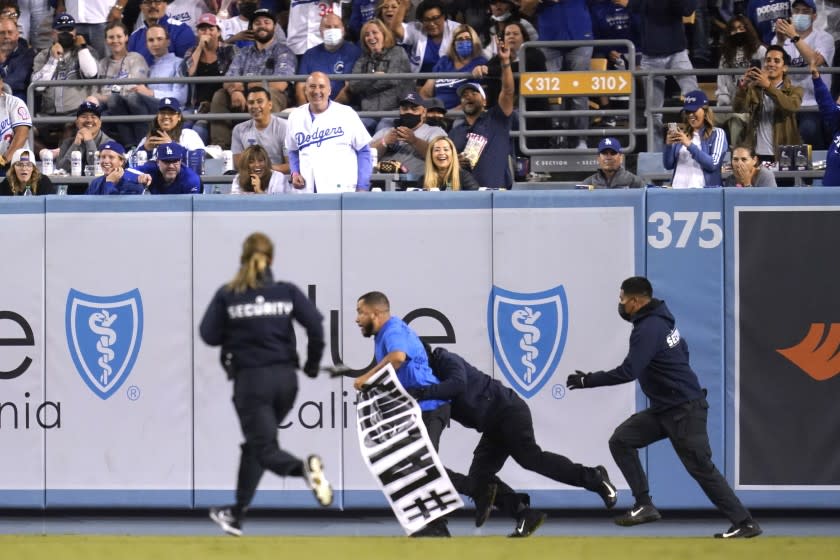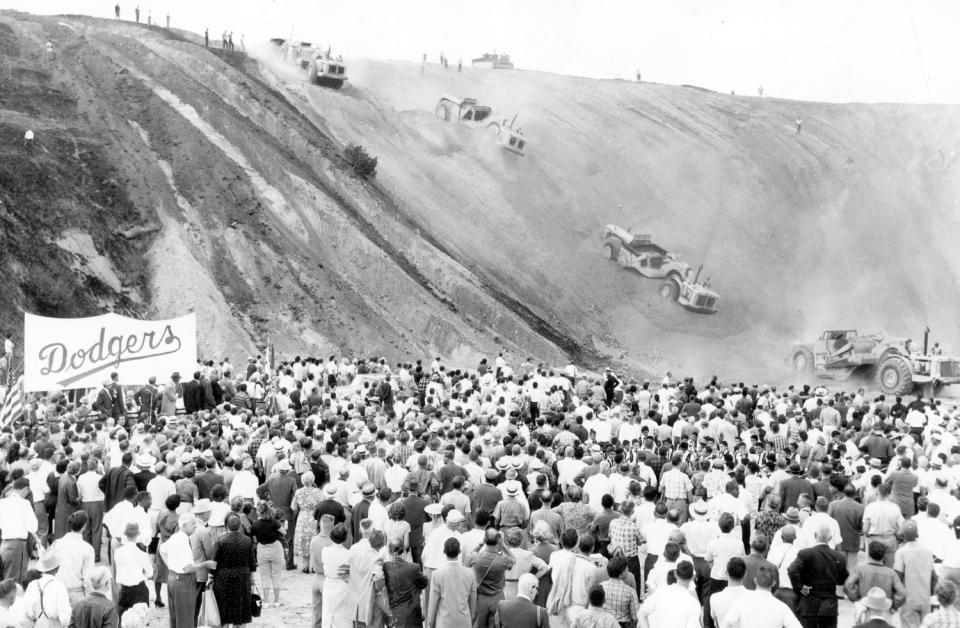Column: They ran out into Dodger Stadium to remind L.A. of a dark moment in Latino history. But fans booed

It was the top of the seventh inning, and the three would-be Latino ghosts from the Dodgers' past sat near the right and left field foul poles.
Suddenly, Edin Enamorado, Wendy Lujan and Panchebel Manahuiatlakatl ran onto the field, holding banners with the names of the barrios that once stood on present-day Dodger Stadium: Bishop. La Loma. Palo Verde. From the right field top deck, someone dropped a banner that read #notchavezravine.
The crowd at first cheered, then looked on quizzically as security chased after the three. Seven alone piled on Enamorado. Then, the fans got angry.
“Raza didn’t want to see the game interrupted,” said Panchebel's father, Jaguar, who was at the game. “They didn’t want history getting in the way.”
In a city that is almost half Latino, in a stadium packed with die-hard Latino Dodgers fans, on Fernando Valenzuela Bobblehead Night at the start of Hispanic Heritage Month, the dredging up of a famously dark moment in L.A.'s history of displacing Latinos played about as well as a game-winning home run by a San Francisco Giant.
Alas, it was not a surprising reaction. Even for a gesture designed to remind people about the uprooting of Latino families 62 years ago that helped clear the way for Dodger Stadium. (On a night that couldn't get more Latino if Edward James Olmos served as an emcee for a pregame celebration of Fernandomania, or an all-woman mariachi performed before the first pitch. Both of which happened.)
My friends and cousins weren't happy when they texted me about the incident. Sure, they all know about the Dodgers' origin story: how L.A. officials promised new housing for residents of Bishop, La Loma and Palo Verde. How the city did a switcharoo and leveled those neighborhoods so Walter O’Malley could move his Brooklyn Bums west. How police officers hauled off the last crying residents from their homes. How the team has never apologized for the fiasco, which they have long maintained they had no part in.
But my friends and cousins, like so many Latino Dodgers fans, shrug about all that. They’d rather talk about how current Dodgers pitcher Julio Urías is the next Fernando.
“Latinos love history — they’ll fight tooth and nail for that,” said Alonso Sarinana, who saw the Sept. 15 game from home and co-hosts the Dodgers-centric "Bleed Los" podcast. He got the same kind of smirking texts from his friends that I did. “But this isn’t a hill they want to die on. The Dodgers are like a religion to us now.”
The protesters had embarked on a Sisyphean task when they ran onto the Dodger Stadium outfield last week.
This week I met that night's Sisyphus-in-chief and his friends at a park in Rosemead.
“I don’t care if the majority doesn’t care,” said Enamorado, as Lujan and the 17-year-old Panchebel nodded in agreement. "It’s about one person who didn’t know and now knows. It’s to seed the future.”
The 33-year-old spoke like the sapling that he is.
Dodger Stadium is literally sacred ground for the lifelong fan: His father and brother were baptized during Jehovah’s Witness assemblies there during the 1990s. Enamorado grew up idolizing Mike Piazza, Eric Karros and Gary Sheffield, teaching kiddie ballplayers the wagging batting stance of the latter when he volunteered as a coach with the Dodgers Foundation in Cudahy Park just two years ago.
“They represented my city,” said the Cudahy resident. “Who we are, what we can be.”
Enamorado, who uses his social media accounts to advocate for street vendors, knew about how the Dodgers came to Los Angeles “but it never registered with me.” Then during a concert this July, a friend gave him a sticker that looked like the Dodgers logo but instead said “Displacers,” complete with a home in place of a baseball. It’s the creation of Buried Under the Blue, a nonprofit headed by Melissa Arechiga and Vincent Montalvo, whose families lost their homes to make way for the Dodgers.
The sticker made Enamorado realize that what happened to those neighborhoods "was worse than Avenue 26,” referring to the popular Lincoln Heights night market that authorities shut down in August. “10 million times worse. We’ve been suffering displacement and gentrification for too long in L.A. It’s a repetitive cycle.”
He looked up Buried under the Blue’s website, which features photos and videos of Arechiga’s family during their last stand, and urges people to not refer to the area as “Chavez Ravine” and instead use the names of the destroyed barrios.
“It’s time to wake up out of the hypnotizing Think Blue,” the home page reads, “by THINKING BROWN!”
The manifesto inspired Enamorado to team up with Lujan and Manahuiatlakatl and launch their fateful runs, which they did while wearing "Displacers" T-shirts.
None of them have any regrets, even though they spent four hours in the catacombs of Dodgers Stadium, then four more hours at the Los Angeles Police Department's Northeast station until Jaguar sprang them (the Dodgers declined to press charges).
“Even if we’re fans, we shouldn’t be afraid to hold the Dodgers accountable,” said Panchebel, who actually roots for the St. Louis Cardinals. “We make up a huge part of their fan base. All we want is acknowledgement about the mistakes of the past and a resolution to so much pain.”
“That’s what a protest is — it’s catching attention for a good cause,” said Lujan, an Upland resident who doesn’t even like sports but sees parallels between #notchavezravine and the anti-eviction movements of today.
I'm not a Dodgers fan, but few places are more magical to me in Southern California than a Dodgers game. It's where I see my SoCal — diverse, happy and muy Latino — gather together for a couple of hours of Cracker Jack-fueled grace.
Every time I go to a game, I do think of the wrongs committed to create this civic good. I deal with it much like I do with knowing that genocide, conquest and slavery helped to birth the United States — I atone for my appeasement of harsh history by telling others about it.
But still I go watch Los Doyers from time to time. And I'd be lying if I said I don't enjoy being in that stadium, even if it's built on a bedrock of oft-forgotten injustice, courtesy of the City of Angels and the Boys in Blue.
The Dodgers had no comment when I told them that Buried under the Blue wants the team to offer restitution to the families whose neighborhoods Los Angeles sacrificed on the altar of America's pastime. And that's part of the problem, said "Bleed Los" podcast host Sarinana.
“If you’re going to relive stuff from 40 years ago, then we might as well relive stuff from even further back," said the 35-year-old San Fernando resident. "The Dodgers now have an opportunity to be on the right side of history by doing their best to preserve what happened instead of sidestepping it."

It's been a long, lonely battle for Montalvo and Arechiga, one so seemingly futile that little kids at reunions for los desterrados ("the uprooted," the nickname some Bishop, La Loma and Palo Verde families gave to themselves) have run around with Dodgers T-shirts. Montalvo's own father, a Mexican immigrant, became a Dodgers fan because of Fernandomania and once wanted to take Vincent to a game.
“And my grandpa who lived in Palo Verde said, ‘What the hell are you doing?’" said Montalvo, now 46 and the Lincoln Heights Neighborhood Council treasurer. "That became a feud for many years between them — my grandpa basically disowned my dad for a while."
But when Montalvo saw Enamorado and his cohorts run onto the field, he described it as “the happiest day of my life.”
“My family was all crying,” said Arechiga, whose great-grandmother Abrana was one of the last holdouts. “The feeling was indescribable. We felt seen for once.”
The two pin their hopes that the Dodgers will own up to their past on a new generation of fans like Enamorado, people who they feel are more socially conscious than older Dodgers fans.
“They’ll think about it, next time they buy a $10 Dodger Dog, or an expensive michelada,” Montalvo said. “Maybe sometime later, they’ll just stop going to games. And maybe the Dodgers will pay attention to our cause just a bit more.”
As for Enamorado, he’s still not fully comfortable with his newfound visibility as a Dodgers critic. After all, he spent many years loving the team.
“It feels like I'm going through a breakup right now,” he said, half joking and half not. “You know it’s ultimately the right thing to do, but right now, it hurts.”
This story originally appeared in Los Angeles Times.

